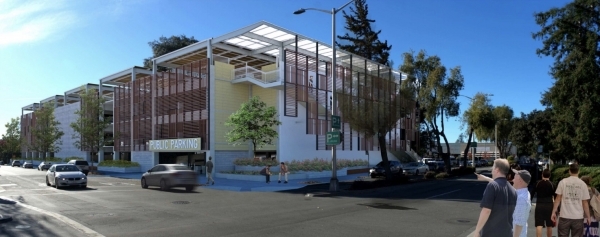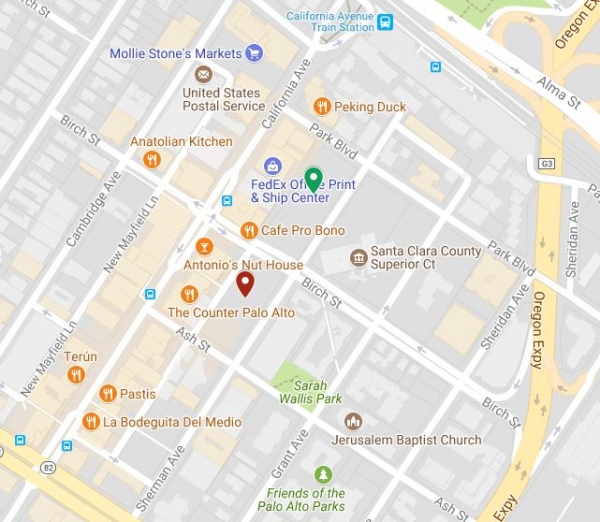After more than two decades of shattered hopes and frustrating setbacks, Palo Alto officials took a big step Monday night toward constructing a new police headquarters when they approved a zone change that will make the project possible.
The City Council voted 8-0, with Councilman Greg Tanaka absent, to approve the environmental analysis and make the required zone changes for the long-awaited public-safety building, which will be constructed in conjunction with a four-story garage. The two new public facilities will occupy city-owned lots at 250 and 350 Sherman Ave., in the California Avenue Business District.
The council's vote sets the stage for construction on Sherman Avenue to commence this fall. The plan calls for first moving ahead with the 636-space garage, a six-level structure with two underground stories, before commencing with the police building. Both projects are expected to be up by fall 2021.
But while the two projects were designed in tandem and were analyzed under the same environmental study, they elicited somewhat different reactions Monday night.
Everyone on the council supports a new public-safety building, a project that the city has pursued since at least the mid-1990s, to replace the existing police headquarters at City Hall.
Over the years, at least six studies had concluded that the existing police headquarters at City Hall is cramped and seismically unsafe. A 2011 study that surveyed the city's infrastructure needs called it "unsafe and vulnerable." Since then, the public-safety building had emerged as the top priority on the council's infrastructure plan, which also includes new garages and a bike bridge over U.S. Highway 101, among other projects.
Several council members acknowledged the long journey before casting their vote. Councilman Greg Scharff called the approval a "huge accomplishment" for a project that many prior councils have tried -- and failed -- to advance over the past 25 years.
"We've been out trying to get a public-safety building for that long," Scharff said. "And every time we got close, it seems to slip through our hands. This time, we're really getting there."
Once built, the new public-safety building will house the Police Department, the 911 Emergency Dispatch Center, the Emergency Operations Center, Office of Emergency Services and Fire Department administration. To accommodate the new buildings, the council approved on Monday a change to the "public facility" zones on Sherman Avenue to make the facilities eligible.
In moving ahead with the two projects, the council largely shared Scharff's enthusiasm for the new public-safety building. The garage, on the other hand, received a more mixed review.
Some area merchants cheered the project, which has grown in scale over recent years thanks in part to lobbying from the California Avenue business community. Jessica Roth, owner of The Cobblery on California Avenue, thanked the council Monday for moving the project ahead.
"The merchants and customers of California Avenue are much appreciative of the extra parking spaces," Roth said.
Others, however, noted that the garage runs counter to recently established policies that aim to deter driving and promote transit and other transportation alternatives. Bret Andersen, member of the group Carbon Free Palo Alto, urged the council to focus on "transportation-demand management" rather than building the new structure, particularly at a time when infrastructure costs are sharply escalating. The new garage is now estimated to cost the city about $47.9 million; the adjacent public-safety building has a price tag of $92.2 million.
Despite the unanimous vote, some council members shared Andersen's concerns about the new garage. Councilman Adrian Fine acknowledged that given the views of his colleagues, the new California garage is effectively a "done deal." It is also, he argued, "a dumb deal."
"We are about to sink $50 million into a concrete building to house cars for a problem (that exists) for two hours per day," Fine said.
Fine called the project a "quintessential giveaway" in that it takes public funds and uses it to build a structure that allows people to park for free. To address this situation, Fine proposed instituting "dynamic pricing" at the new California Avenue garage, with rates changing based on demand. His proposal advanced by a 5-4 vote, with Scharff, Vice Mayor Eric Filseth and council members Lydia Kou and Tom DuBois dissenting.
Councilman Cory Wolbach agreed with Fine and called parking a "valuable resource." Pointing to a "growing amount of skepticism" about this garage and the city's budget challenges, Wolbach said charging for parking is the responsible thing to do.
Councilwoman Karen Holman was more amenable to the new parking structure, though she panned its design as lacking a "pedestrian feel." Fine responded that a garage, inherently, is "anti-pedestrian."
Mayor Liz Kniss agreed.
"Somehow, we're heading into an odd direction when we're talking about EVs (electric vehicles) and carbon taxes and so forth and we've ended up here voting for an enormous garage," Kniss said.
Others were more enthusiastic about the prospect of building a garage in an area where frustrations about parking shortages have been running rampant for years. DuBois said that the sooner the facility is built, the better.
"This is one of the few projects that I've seen that residents and businesses came together and said they really wanted it," DuBois said.




Comments
Registered user
Escondido School
on Jun 12, 2018 at 10:45 am
Registered user
on Jun 12, 2018 at 10:45 am
Thank you to advocates from Carbon Free Palo Alto for calling the City Council's attention to the deficiencies in the Environmental Impact Report that was on the Council's agenda for approval last night. Simply put, the Council did not require even token consideration of alternatives to spending $48+ million of public funds to subsidize daytime housing for 636 automobiles. So, despite a commitment in the City's Sustainability Plan to reducing solo driving by 30% in the next 12 years, we will be heavily subsidizing parking for the main source of greenhouse gas production in our fair city: driving solo. Yes, it's true that some drivers do not have an alternative to driving -- but proven programs like those our City has imposed on Stanford University can provide viable alternatives that reduce parking demand by 20% or more. Even a weak program of incentives to reduce driving (like that used in the Downtown TMA) can reduce parking demand by 10% in a single year.
Thank you to the five council members who voted for the baby step of considering dynamic pricing for the privilege of parking in this heavily subsidized garage. DuBois, Scharff, Filseth and Kou, however, demonstrated major lack of credibility on their purported commitment to sustainability and reducing the impact of climate change.
Downtown North
on Jun 12, 2018 at 3:34 pm
on Jun 12, 2018 at 3:34 pm
The City's Sustainability Plan is a flashy trophy to be gushed over in state of the city speeches and other bragfests like council comments sessions. Otherwise it stays in the broom closet when the city conducts its real business.
Downtown North
on Jun 12, 2018 at 6:08 pm
on Jun 12, 2018 at 6:08 pm
If only the city council had established a "Police Building Fund" all those years ago when they started to have meetings and talks about a new building. If they had, we wouldn't have to float bonds and raise hotel taxes to pay for this building but would have the money in hand.
The city needs to act more like smart homeowners and save for what they want to buy rather than raise taxes and pass bonds (that cost more money) to pay for what they suddenly decide they want.
If they had started a fund to trench the trains over the last 20 years that they have been talking about it, we would have quite a fund by now.
Where is the planning for the future and thinking about saving for what you want approach in this city?
Midtown
on Jun 12, 2018 at 8:22 pm
on Jun 12, 2018 at 8:22 pm
As I've said before: it's a bad idea to put emergency services in a place where they can't access the majority of the city during rush hour. Lights and sirens do nothing when there is physically no passable space on Page Mill underneath the railroad tracks while traffic is backed up every afternoon.